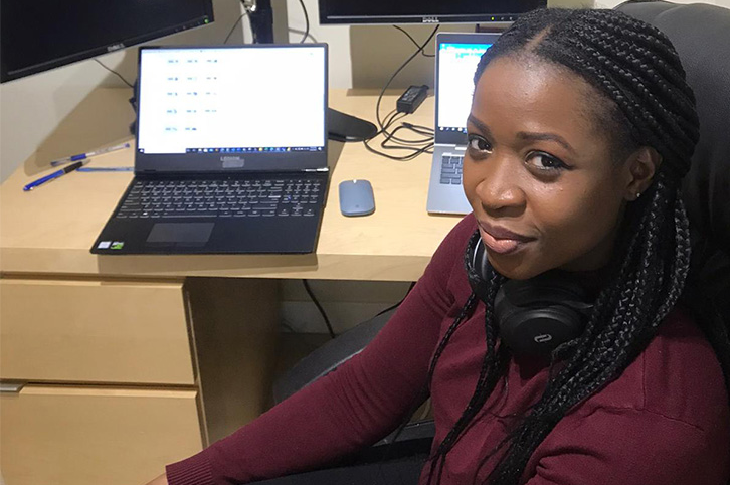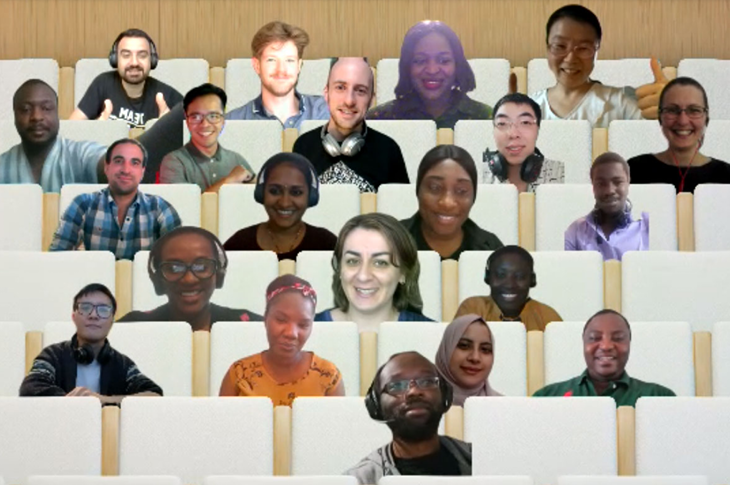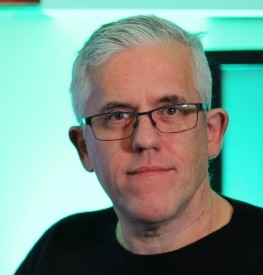Shifting career gears: Evolving skills for an evolving economy

“The skills I developed helped launch me into a professional role as an analytics consultant in the industry.”
Moving to a new country is a lot like starting from scratch. Dammy Oyekan can attest to that. Despite having previous experience in the financial sector, she found it difficult to find a job in the field after she made the move from Nigeria to Canada in 2019. Refusing to settle for just any career, she knew it was time to enhance her skill set and turned to SAIT’s Business Intelligence Data Analysis and Reporting program.
What were you doing before you enrolled at SAIT?
I had just moved to Calgary from Nigeria with my family and was going through the transition of settling into a new environment. Professionally, I spent five years working in controls, risk and audit at a financial institution back home.
What made you decide to upskill at SAIT?
As a new immigrant, I started applying for audit jobs and was mostly met with rejection. Upon reflection, and looking through the requirements for these jobs, I realized quickly that in order to apply my previous skills and experience in the evolving Calgary economy, I had to upskill myself.
I consulted with a former colleague who was thriving as a business intelligence analyst here in Calgary. He shared with me his experience and highlighted how the SAIT Business Intelligence Data Analysis and Reporting program had helped him gain the exposure he required. At that moment I knew I had to enrol in the program.
What was your experience like in the Business Intelligence Data Analysis and Reporting program?
My program started at the peak of the pandemic. I feared taking my child to daycare but also wasn’t sure how I would cope having her around during classroom hours. It was difficult, but I made the decision to enrol her. Time management proved challenging for the first few weeks. However, because I had a great support system, I was able to establish a schedule that worked for everyone.

With respect to the program’s content and delivery, the faculty exhibited a high level of excellence, quality and innovation. Although the classes were virtual, the facilitators provided assignments, workshops and labs that allowed us to experience teamwork and build a community. I met new people from diverse backgrounds who are now part of my close circle and network. Overall, it was a wonderful experience as I was taught the amazing things our minds can accomplish when they are set to achieve something monumental.
What were some of the highlights of your experience?
Since this was my first experience of a virtual classroom program, I enjoyed the idea of being able to join classes in my pajamas with a cup of hot chocolate and homemade cookies. Also, the integration of technology in the program addressed the need for some practical skills development. We completed real-time labs working with databases and visualization platforms that made for a holistic learning experience.
I was also able to take advantage of the SAIT library and LinkedIn Learning, which was also a great resource for learning fundamentals.
And, of course, I enjoyed having group study time with some of my classmates who I now consider friends.
How did you land your practicum with Iteration Insights?
The search for an organization for the practicum proved to be difficult at first. Several applications were met with rejections, mainly related to the fact that companies required individuals with more experience than I had, and also due to the ongoing pandemic. Fortunately, with the ongoing tech transition in Alberta, positions in business intelligence and data analysis have become more in demand.
A few weeks into my job search, the hiring manager from Iteration Insights reached out to me about an opportunity to start my practicum with them. During my time at SAIT, I had the opportunity to learn from guest lecturers Chris Sorenson and Tutu Hamid, who are part of the Iteration Insights family, so the opportunity to work with the company was the boost my career needed and definitely an experience I was looking forward to.
After my eight-week practicum, I was invited to stay on with the company on a contract basis as an analytics consultant.
How do you think upskilling prepared you to get to where you are today?
Although it was a fast track program, I learned the fundamentals of business intelligence, covering a breadth of modern technology applications and real use cases. The skills I developed helped launch me into a professional role as an analytics consultant in the industry. The program was structured to give time for both theoretical and practical learning and my eight-week practicum gave me the extended knowledge I needed.
Content from courses I took, such as Database Management, Database Architecture, and Reporting and Analytics has now become a routine part of my job and have certainly helped me in the delivery of projects.
What would you say to someone who was in a similar situation and considering upskilling?
I would encourage them to do their research, find the right program applicable to their choice of profession, and to give their best on every task and take on every challenge.
The hiring manager at Iteration Insights revealed she had been part of the audience for my final Power BI project presentation at SAIT and was impressed with my content and storytelling. This just goes to show how important it is to give your best and take on every challenge with the desire to provide value. This approach and attitude will be evident in the quality of your work and will not go unnoticed.
Is there anything else you’d like to add?
My experience as a SAIT student has been a memorable one. I am even more enthusiastic about how much I can contribute to the forever changing world of business intelligence. I’m encouraged to take every day as a stepping stone and continuously work to improve my skills.
Learn from a SAIT and industry expert in business intelligence and data analysis

Being future-proof is all about being able to continually assess the value that you bring to an organization or business through the skills and application of critical thinking. The ability to contextualize the solutions you provide will be the ultimate test of their impact — and yours.
- Frank Bergdoll, MA, Instructor, School of Information and Communications Technologies
Read more shifting gears stories — and write your own!
Read Rigel's story
After barely getting through his first degree and trying to enter into a workforce that looked grim, SAIT international student Rigel Raju enrolled in SAIT's Bachelor of Business Administration (BBA) program and was sure to make it count this time.
Reboot your career
Be part of what's next. Explore programs within SAIT's School for Advanced Digital Technology.
Learning for Life
We prepare students for successful careers and lives.
SAIT'S
2020-2025
Strategic plan

Oki, Âba wathtech, Danit'ada, Tawnshi, Hello.
SAIT is located on the traditional territories of the Niitsitapi (Blackfoot) and the people of Treaty 7 which includes the Siksika, the Piikani, the Kainai, the Tsuut’ina and the Îyârhe Nakoda of Bearspaw, Chiniki and Goodstoney.
We are situated in an area the Blackfoot tribes traditionally called Moh’kinsstis, where the Bow River meets the Elbow River. We now call it the city of Calgary, which is also home to the Métis Nation of Alberta.